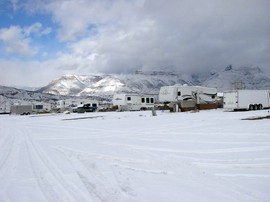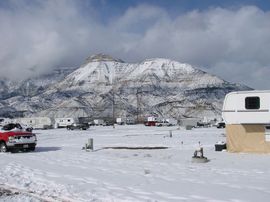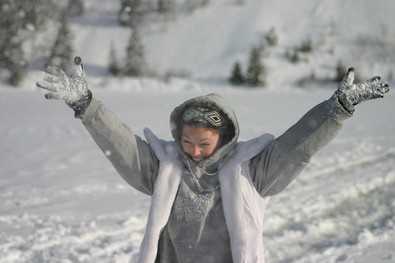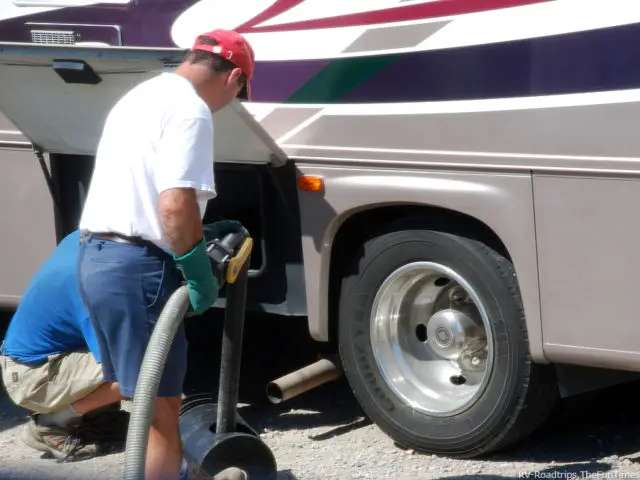 Most fulltime RVers head south for the winter — making sure they’re well below the snowbelt before the first snowflakes of winter start to fall.
Most fulltime RVers head south for the winter — making sure they’re well below the snowbelt before the first snowflakes of winter start to fall.
This is all well and good if you’re retired, or able to take your source of income along with you. What about those forced to stay put because of their job or other reasons?…
Is it possible to survive the winter months in an RV?
Absolutely!
My wife and I spent 2 winters with snow, ice, and below-zero temperatures in our 5th wheel trailer while we were living in Denton, Texas. It did take a bit of effort on our part to remain warm and comfortable, but yes it can be done.
If you’re fortunate enough to own an RV that was specifically built for cold weather, then life in the snowbelt will be much easier.
With waste tanks insulated and heated, and double pane windows combined with additional insulation, your only real concern is protecting the water line that is attached to the city water port.
Most travel trailers (like our current Dutchman) have exposed water and waste tanks. With modifications, winterizing such an RV is possible. It will be a big project, but it can be done.
Retaining Heat Inside Your RV
 I’ve seen where one RV trailer owner installed an enclosed plywood bottom on their trailer complete with insulation to protect his water tanks.
I’ve seen where one RV trailer owner installed an enclosed plywood bottom on their trailer complete with insulation to protect his water tanks.
I’m sure he also provided for forced-air heat to enter this protected area too, since this would be the only way to keep the tanks from freezing. That additional insulated floor would go a long way in helping keep the living space warm too.
One trick we used to help retain heat was to make some Styrofoam panels cut from half-inch sheets of insulation to fit into most of the windows. Glass doesn’t hold in much heat, so by covering all but the main living room windows there was much less heat loss.
For those hearty souls who are far enough into the snowbelt to have an accumulation of snow, then banking the snow around your RV will help a lot in terms of heat retention. Snow used to seal up the underside will stop the cold wind from blowing under your portable residence.
Using bales of hay is not recommended because critters will move right in with you for the winter! Plywood or other similar material used to form a skirting around your RV will give you something to pile the snow against without providing a food source for animals.
Double-check exhaust pipes and vents to prevent blockages from drifting snow. You definitely don’t want these fumes coming back inside! ~Camping World
How To Keep The RV Water Line From Freezing
To protect that ever-important water line, we attached an electrical heat tape running the full length of the exposed hose. We then encapsulated the hose in split Styrofoam pipe insulation.
Luckily, in Texas frost doesn’t go down very deep, so we only had to protect the exposed portion of garden hose. We dug a trench and buried most of the garden hose and let Mother Earth do the insulating.
Winterizing The Sewer Line
For the sewer line, instead of using the standard slinky style hose that you can buy at the RV dealer, we went to the home center and bought hard line PVC tube and built a more substantial setup.
By installing it with a modest slope, we were assured that it would drain quickly — so it didn’t need any further insulation.
Make Sure You Have Enough Propane On Hand
Staying warm requires that the furnace is working properly.
To maintain a supply of propane, we installed an Extend-a-Stay kit which allowed us to add additional 30-pound bottles of propane. If you’re staying put for a number of months you may want to arrange for a large 100-pound propane tank to be delivered. With smaller bottles, we made weekly trips to the local propane dealer for refills.
If you rely on your RV propane furnace to provide all your heat, you will find it running almost continually. Most RVs are lacking in quality insulation, and heat loss will require that you use lots of fuel.
(I never said living in and RV through the winter would be economical, but it can be done.)
To help conserve propane we did 2 things:
- We had 2 portable electric heaters that we stationed at each end of our 37-foot RV. (Always be sure to use heaters that have “tip over protection” and position them away from combustible materials.)
- We also used a portable propane catalytic heater to provide additional heat. A better choice would have been a high-output permanently mounted catalytic heater. These are much more efficient than your onboard forced-air heater
and they require no electricity. Catalytic heaters are the proven best choice if you’re boondocking away from electrical power. Be sure any propane heater you use has a “low oxygen” shutdown and that you have both a carbon monoxide detector and a flammable gas leak detector in your RV.




